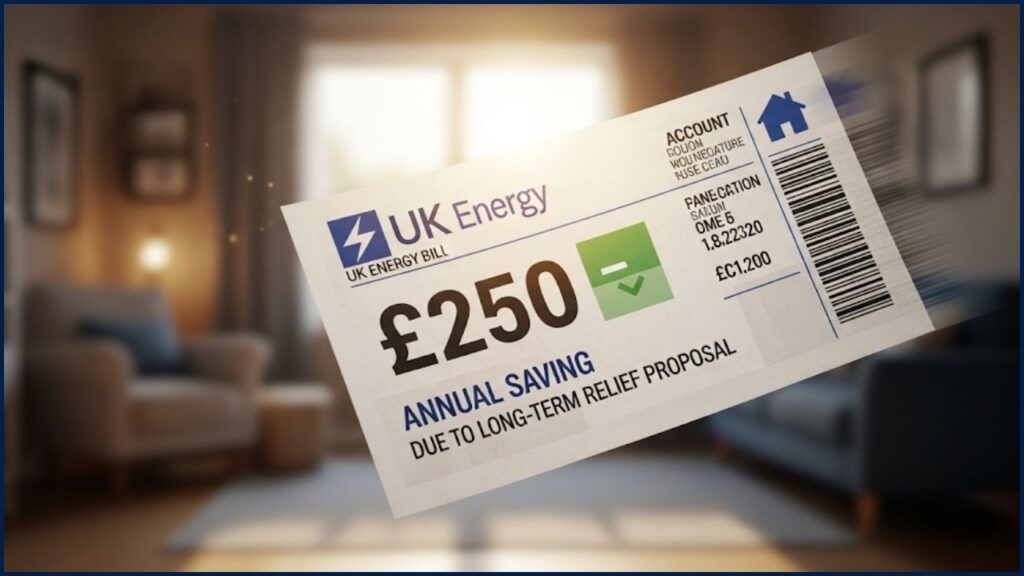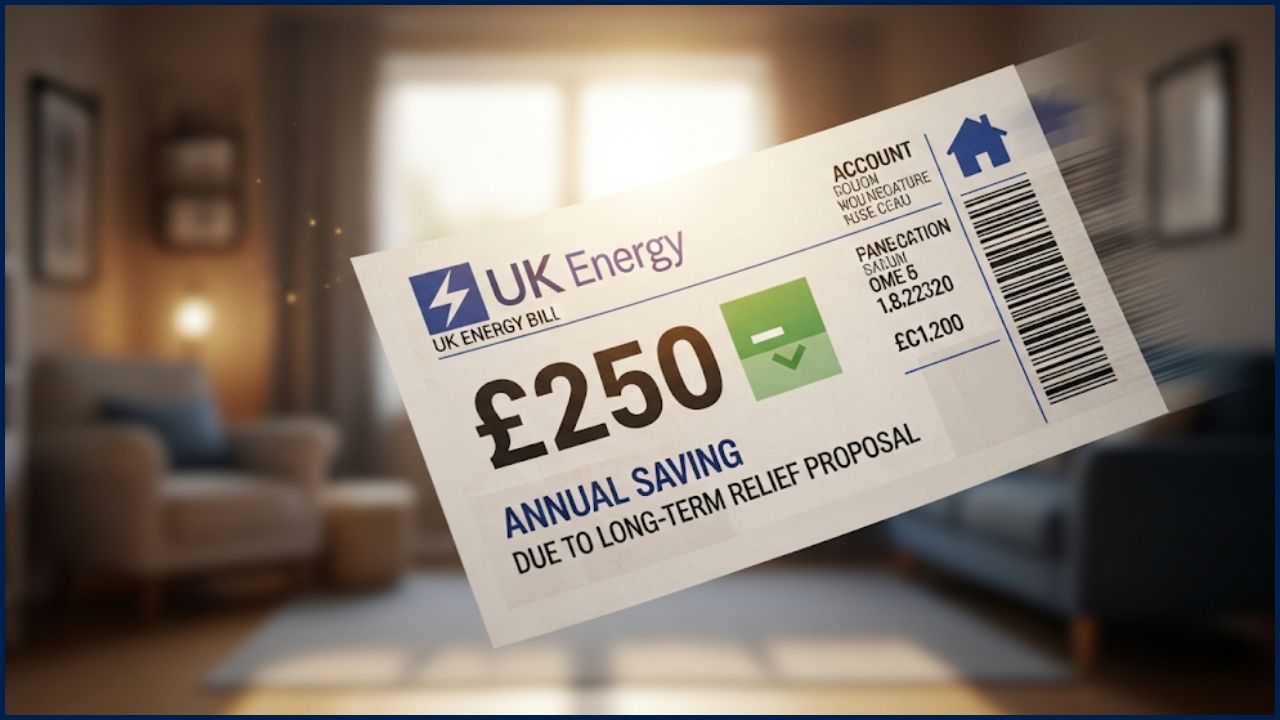If you’ve been sweating over your electricity bills lately (and not just from the summer heat), here’s a breath of fresh air: UK households could soon see their annual energy bills cut by up to £250 — every year for a decade — thanks to a new government proposal. And no, this isn’t a “too-good-to-be-true” gimmick. It’s part of a broader clean energy infrastructure expansion plan that also aims to smooth over tensions in communities near new power lines.

The UK government recently announced a long-term relief program that would provide households living within 500 meters of new or upgraded electricity pylons or transmission infrastructure a £125 discount on their energy bill every six months. Over 10 years, that’s up to £2,500 total in savings for eligible homes.
UK Energy Bills Could Drop by £250 Annually
| Feature | Details |
|---|---|
| Annual Savings | Up to £250 per household |
| Eligibility | Homes within 500 m of new/upgraded pylons or transmission lines |
| Duration | 10 years (total savings up to £2,500) |
| Additional Benefits | Smart meter reforms with compensation for delays |
| Official Source | Gov.uk Announcement |
| Implementation Start | Planning and Infrastructure Bill timeline (pending parliamentary approval) |
The UK’s £250/year energy bill relief plan is more than just a budget boost — it’s a clever strategy to push the clean energy grid forward while keeping local residents on board. If you live near future pylon projects, you might soon see your electricity bills shrink without lifting a finger. And with smart meter compensation kicking in by 2026, customers could see even more perks.
Why This Matters
Energy costs have been a hot-button issue for years, especially since wholesale electricity prices shot up during the global energy crisis. While prices have begun to cool off, many families still feel the pinch.
This plan isn’t just about being generous — it’s strategic. The UK is pushing hard toward a greener grid, with more offshore wind, solar farms, and cleaner power plants. But here’s the rub: all that clean energy has to travel long distances to reach your home, and that means building more high-voltage transmission lines.
Nobody’s exactly thrilled about waking up to a new set of giant pylons in their backyard. This discount acts like a thank-you bonus for communities that live closest to the infrastructure.
Historical Context — We’ve Seen This Before
This isn’t the first time the UK has offered energy bill relief.
- During the 2022–2023 energy crisis, the Energy Bills Support Scheme provided a one-off £400 payment to every household.
- The Warm Home Discount still offers £150 off winter bills for low-income households.
What’s different now?
Unlike previous blanket support, this is location-specific, tied directly to where infrastructure is built.
Breaking It Down: How the £250 Savings Works
Let’s make this super clear, step-by-step:
Step 1 — Location, Location, Location
If your home is within 500 meters (about five football fields) of new or upgraded pylons or high-voltage transmission lines, you’ll automatically be on the eligibility list.
Step 2 — Payment Schedule
You’ll get £125 off your bill twice a year — once in summer, once in winter. This discount comes straight from your electricity supplier, not as a one-off government cheque.
Step 3 — Duration
The benefit lasts for 10 years from when the project is completed. Over time, you could pocket up to £2,500.
Step 4 — Smart Meter Benefits
From 2026, energy suppliers will be legally required to compensate you if they take more than six weeks to install a smart meter, or if repairs drag on too long.
Real-Life Scenarios
Example 1 — The Rural Family
Sarah and Tom live in a small village in Yorkshire. A new transmission line is planned 300 meters from their home. They’ll get £250/year off their electricity bills for 10 years — that’s like covering two months’ worth of average bills annually.
Example 2 — The New Mover
James buys a home in 2027 that’s within 500 meters of an upgraded pylon line. Even though he wasn’t there during construction, he still gets the benefit because it’s tied to the property.
Expert Insight
According to Claire Coutinho, UK Secretary of State for Energy Security:
“Our clean energy ambitions depend on a stronger grid. By offering direct financial benefits to those most impacted, we’re ensuring local communities share in the rewards of Britain’s energy transition.”
Energy policy analyst Dr. Martin Lewis adds:
“This is a pragmatic step. It won’t erase opposition to pylons, but it creates a fairer relationship between national needs and local impacts.”
US Parallels
In the United States, utilities often provide easement payments or bill credits to landowners affected by transmission projects. For example, in Texas, some residents receive annual rent-like payments for hosting power infrastructure. While the UK’s approach is broader (covering entire neighborhoods within 500 m), the principle is the same — share the benefits with those most directly impacted.
Economic Impact
If fully implemented, the scheme could:
- Affect tens of thousands of households near major grid upgrades.
- Inject millions in bill savings into local economies.
- Improve approval times for infrastructure, potentially cutting delays by 6–12 months.
Faster builds mean lower grid costs, which, according to Ofgem, could save all UK consumers up to £1 billion/year by 2030.
Practical Advice: How to Check if You Qualify
Here’s your quick guide:
- Check upcoming infrastructure plans in your area — these are usually listed on your local planning authority’s website.
- Visit the UK Planning Portal and search for “Nationally Significant Infrastructure Projects.”
- Keep tabs on National Grid announcements — they post maps of proposed projects.
- If your home’s close to the construction zone, contact your energy supplier and ask if they’re tracking eligibility under the new scheme.
- Use mapping tools like Google Earth to measure the 500-meter distance.

Comparison Table
| Feature | New Long-Term Proposal | Previous Crisis Schemes (e.g., Energy Price Guarantee) |
| Duration | 10 years | Short-term (e.g., 6-12 months) |
| Eligibility | Households within 500m of new or upgraded pylons | All households (or those on specific benefits) |
| Benefit Type | Direct, recurring discount on electricity bill | Price cap or one-off payments |
| Total Value | Up to £2,500 per household | Variable based on market rates and scheme duration |
| Primary Goal | Incentivise infrastructure development | Cushion the impact of immediate price spikes |
The Smart Meter Rule — Why It Matters
Smart meters can help track real-time usage, spot waste, and shift energy use to cheaper times. But the rollout has been… let’s just say… slower than molasses in January.
The new compensation rule means:
- If your smart meter install takes over 6 weeks after you request it → you get paid.
- If repairs aren’t done quickly → you get paid.
This could encourage suppliers to step up their game and reduce the waitlist backlog.
Challenges Ahead
- Public trust: Some communities may still oppose pylons, even with financial incentives.
- Eligibility disputes: Borderline cases (just over 500 m) could lead to complaints.
- Funding clarity: The plan will need clear rules on whether costs are covered by suppliers, taxpayers, or both.
FAQs
Q1: Do I need to apply for the £250 annual discount?
Most likely not. The plan is designed for automatic enrollment based on your address, though final details depend on your supplier’s implementation.
Q2: What if I move during the 10 years?
The benefit stays with the property, not the person. If you move into an eligible home, you get the discount.
Q3: Does this affect my other energy rebates?
Nope. It’s on top of any other government schemes like the Warm Home Discount.
Q4: What’s the official start date?
The plan’s in the proposal stage but tied to the Planning and Infrastructure Bill. Assuming parliamentary approval, rollouts could start within 18–24 months












